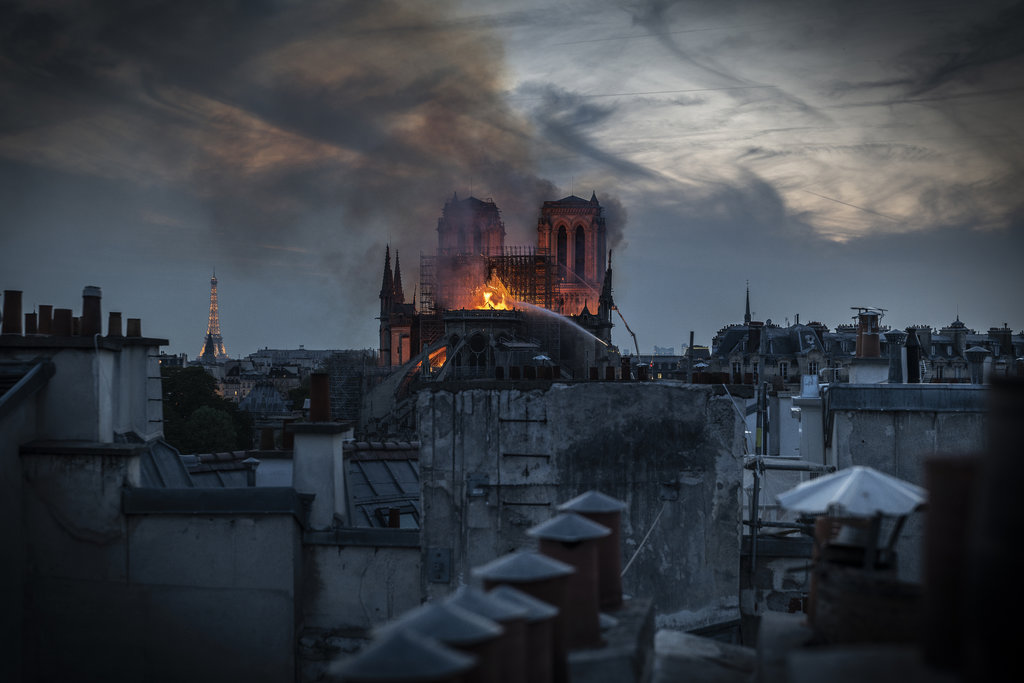From the Ashes of Notre-dame
By Ross Douthat
A first draft of this column was written before flames engulfed the Cathedral of Notre-Dame de Paris, before its spire fell in one of the most dreadful live images since Sept. 11, 2001, before a blazing fire went further than any of France’s anticlerical revolutionaries ever dared. My original subject was the latest controversy in Catholicism’s now-years-long Lent, in which conflicts over theology and sex abuse have merged into one festering, suppurating mess. The instigator of controversy, this time, was the former pope, the 92-year-old Benedict XVI, who late last week surprised the Catholic intelligentsia with a 6,000-word reflection on the sex abuse crisis. Portions of the document were edifying, but there was little edifying in its reception. It was passed first to conservative Catholic outlets, whose palpable Benedict nostalgia was soon matched by fierce criticism from Francis partisans, plus sneers from the secular press at the retired pope’s insistence that the sex abuse epidemic was linked to the cultural revolution of the 1960s and the 1970s. The column I was writing before the fire was mostly a lament for what the document’s reception betokened: A general inability, Catholic and secular, to recognize that both the “conservative” and “liberal” accounts of the sex abuse crisis are partially correct, that the spirits of liberation and clericalism each contributed their part, that the abuse problem dramatically worsened during the sexual revolution (a boring empirical fact if you spend any time with the data or the history) even as it also had roots in more traditional patterns of clerical chauvinism, hierarchical arrogance, institutional self-protection. So the column was a defense of Benedict’s argument, in part, against secular sneers and liberal-Catholic sniping. But then it also agreed with certain criticisms of his letter, and worried about the ways that such an intervention contributes to the sense of a church in pieces, a church almost with two popes, each offering partial diagnoses to their respective factions. That’s where I was, what I had at least half-written, before the fire began in Paris. But now let me try to say something larger, something commensurate to the symbolism of one of Catholicism’s greatest monuments burning on Holy Week, a day before Benedict’s own birthday, on the day after Catholics listened to a gospel in which the veil of the temple was rent from top to bottom. That larger thing is this: The problem of Catholic narratives that can’t find synthesis, of “liberal” and “conservative” takes that feed angrily off one another, of popes and former popes as symbols grasped by partisans, is not the problem of the sex abuse crisis. It is simply the problem of Roman Catholicism in this age — an age in which the church mirrors the polarization of Western culture, rather than offering an integrated alternative. The church has always depended on synthesis and integration. That has been part of its genius, a reason for all its unexpected resurrections and regenerations. Faith and reason, Athens and Jerusalem, the aesthetic and the ascetic, the mystical and the philosophical — even the crucifix itself, two infinite lines converging and combining. Notre-Dame de Paris is a monument to a particularly triumphant moment of Catholic synthesis — the culture of the high Middle Ages, a renaissance before the Renaissance, at once Roman and Germanic but both transformed by Christianity, a new hybrid civilization embodied in the cathedral’s brooding, complicated, gorgeous sprawl. The Catholicism of today builds nothing so gorgeous as Notre-Dame in part because it has no 21st-century version of that grand synthesis to offer. The reforms of the 1960s, the Second Vatican Council and everything after, have left the church partially and unsuccessfully transformed, torn between competing visions of how to be Catholic in modernity, competing promises of renewal and reform, competing factions convinced that they are the firefighters inside Notre-Dame, and their rivals are the fire. I belong to one of these factions (or to a faction within a faction; who can keep track?); I am a conservative of some sort, who fears that liberal Christianities usually end up resembling a post-inferno cathedral, with the still-grand exterior concealing emptiness within. But I am also doubtful that anything so simple as a conservative “victory” will return the church to cathedral-raising vigor and make it feel, to outsiders, like something more than a museum whose docents all seem to hate one another. Especially given how often conservative Catholicism is in thrall to orthodoxies that are political rather than theological, how often — especially as it reacts to the destabilizing style of Pope Francis — its climate feels more like an airless bunker than a Gothic nave. And it is impossible, as a Catholic, to be writing about this subject while the Cathedral of Notre-Dame is literally burning on Holy Week and not feel that everyone engaged in Catholicism’s civil wars is being judged, and found wanting, and given a harrowing lesson in what is actually asked of us. The cathedral will be rebuilt; the cross and altar and much of the interior survived. But all preservation is provisional. The real challenge for Catholics, in this age of general post-Christian cultural exhaustion, is to look at what our ancestors did and imagine what it would mean to do that again, to build anew, to leave something behind that could stand a thousand years and still have men and women singing “Salve Regina” outside its cruciform walls, as Parisians did tonight while Notre-Dame burned. What is the synthesis that could make that possible? What lies beyond the stalemates and scandal and anger of our strange two-pope era? Go ask the Catholics of 3019 A.D. It’s for them to know, and us, if God wills it, to find out.
|
.
Any original material on these pages is copyright © BishopAccountability.org 2004. Reproduce freely with attribution.
